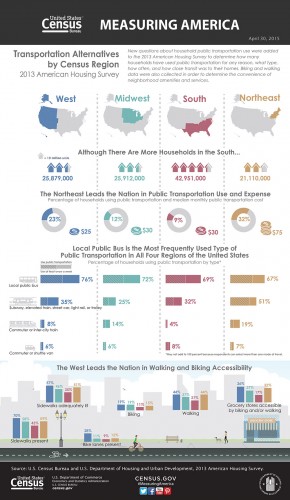The U.S. Census Bureau added new questions to the 2013 American Housing Survey to determine how many American households use public transit, walk, and bike as a means of transportation, how often, and how convenient it was. The Bureau also collected information about neighborhood amenities and services to determine how convenient they were for walking and biking. The result is a recently-released a downloadable infographic that illustrate’s their findings.
The survey shows that the West, which includes all the states in the U.S. from Colorado to the Pacific, leads the nation in walking and biking accessibility. Western cities have the highest number of sidewalks and adequately lit sidewalks, available bike lanes, percentage of people that bike, and the number of grocery stores within walking or biking distance. The West even ties the Northeast in the percentage of households that walk—a hefty accomplishment considering the large number of compact, walk-friendly cities in the Northeast.
 The group of states designated as the South, which spans from Delaware to Texas, has twice as many households as in the Northeast, however Northeastern households use public transportation three times more than those in the South. Although, transit is somewhat cheaper in the Northeast—the median monthly spend is only 2.5 times greater.
The group of states designated as the South, which spans from Delaware to Texas, has twice as many households as in the Northeast, however Northeastern households use public transportation three times more than those in the South. Although, transit is somewhat cheaper in the Northeast—the median monthly spend is only 2.5 times greater.
Bus use is highest in the West—76% of households say they take the bust at least once per week—while subway use is not surprisingly highest in the Northeast, which includes Philadelphia, Boston, and New York, the three cities with the oldest subway systems in the U.S. Frommer’s lists New York City as having one of the 10 best subway systems in the world.
The Census Bureau reports that while biking and walking make up a relatively small percentage of daily commutes—only 6.1% of workers commute by bike in Portland, OR, one of the most bike-dense cities in the nation, and only 3.4% in San Francisco—these nonmotorized travel modes play an important role within the country’s local transit systems and complement other transportation options.
“Through efforts to increase local transportation options, San Francisco, along with many other large U.S. cities, has contributed to the increase in the number of people who bike to work,” said Brian McKenzie, a Census Bureau statistician who studies commuting.
A number of cities across the country are taking an active step toward increasing walking, biking, and public transit use. Citywide bikeshare programs like Austin, TX’s B-Cycle and even hyper-local initiatives like the walking school bus program at St. Theodore Catholic School in Albert Lea, MN, are working to encourage people to get out and walk and bike, as well as give them a way to do it.
“School leaders are in a powerful position to dramatically improve students’ well-being,” said Stacy Palmer of the Blue Zones Project, which seeks to encourage healthy activities in communities across the U.S.
Main image courtesy of the San Francisco Bike Coalition via Flickr.
Like this post? How about these: